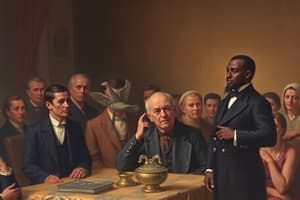Podcast
Questions and Answers
Which of the following best exemplifies the concept of 'passing' as white in the early to mid-20th century United States?
Which of the following best exemplifies the concept of 'passing' as white in the early to mid-20th century United States?
- A Native American family relocating to a city and adopting mainstream American customs to integrate into society.
- A Mexican American individual learning to speak fluent English to secure a job in a predominantly white company.
- A light-skinned African American individual claiming Arab ancestry to explain their complexion and be accepted as white. (correct)
- An Asian American family changing their last name to a more 'Americanized' version to avoid discrimination in housing.
The acceptance of the marriage between Lucy and Ricky (from I Love Lucy) by the American public in 1950 suggests that:
The acceptance of the marriage between Lucy and Ricky (from I Love Lucy) by the American public in 1950 suggests that:
- Marriages between Jewish and Christian individuals were more accepted than other forms of interfaith marriage.
- Interracial marriages involving white individuals and people of Asian descent were becoming increasingly accepted.
- The American public was largely tolerant of interracial marriages at the time, regardless of the races involved.
- Light-skinned Cubans were considered white, and therefore their marriage was not viewed as an interracial one. (correct)
What was the general attitude towards interracial marriage in the United States as late as 1958?
What was the general attitude towards interracial marriage in the United States as late as 1958?
- About half of Americans were indifferent to interracial marriage, neither approving nor disapproving.
- While there was still some disapproval, most Americans were becoming more tolerant of interracial marriage.
- Only a small percentage of Americans approved of interracial marriage, indicating widespread disapproval. (correct)
- A majority of Americans approved of interracial marriage, viewing it as a step towards greater social equality.
The fact that Anglo-American whites were not typically ostracized for marrying Irish or Italian Americans suggests that these groups were:
The fact that Anglo-American whites were not typically ostracized for marrying Irish or Italian Americans suggests that these groups were:
What is the significance of mentioning that Will Rogers was 9/32 Cherokee?
What is the significance of mentioning that Will Rogers was 9/32 Cherokee?
The 'racist pseudo-science of the day' divided Europeans into various races. What was the primary function of this division?
The 'racist pseudo-science of the day' divided Europeans into various races. What was the primary function of this division?
The claim that turn of the century Americans referred to the 'Irish race' or the 'Jewish race' is used to illustrate what point?
The claim that turn of the century Americans referred to the 'Irish race' or the 'Jewish race' is used to illustrate what point?
What is a key criticism of "whiteness studies" as described in the content?
What is a key criticism of "whiteness studies" as described in the content?
What is the central argument against the claim that certain European ethnic groups were not initially considered 'white' in America?
What is the central argument against the claim that certain European ethnic groups were not initially considered 'white' in America?
Which of the following is NOT presented as an 'objective test' for determining whether a group was historically considered 'white' in the United States?
Which of the following is NOT presented as an 'objective test' for determining whether a group was historically considered 'white' in the United States?
What is the significance of Jim Crow laws in evaluating whether a group was considered 'white'?
What is the significance of Jim Crow laws in evaluating whether a group was considered 'white'?
According to the author, what is a key difference between the 'whiteness studies' perspective and the historical reality of how certain groups were treated in the U.S.?
According to the author, what is a key difference between the 'whiteness studies' perspective and the historical reality of how certain groups were treated in the U.S.?
What is the author implying when he uses the phrase 'objective tests' to describe the criteria for determining whiteness?
What is the author implying when he uses the phrase 'objective tests' to describe the criteria for determining whiteness?
How does the historical existence of anti-miscegenation laws relate to the question of whether a group was considered 'white'?
How does the historical existence of anti-miscegenation laws relate to the question of whether a group was considered 'white'?
What would be the likely implication if labor unions historically excluded members of a particular ethnic group based on 'whites-only' restrictions?
What would be the likely implication if labor unions historically excluded members of a particular ethnic group based on 'whites-only' restrictions?
What is the author's primary concern regarding the contemporary application of 'whiteness studies' in the context of American ethnic history?
What is the author's primary concern regarding the contemporary application of 'whiteness studies' in the context of American ethnic history?
Flashcards
Whiteness Studies
Whiteness Studies
The academic study of the historical, social, and cultural constructs of 'whiteness'.
Delayed 'Whiteness'
Delayed 'Whiteness'
The idea that certain European ethnic groups (like Irish, Italians, Jews) were not considered 'white' until the mid-to-late 20th century.
Sociological 'Whiteness'
Sociological 'Whiteness'
A sociological or anthropological understanding of 'whiteness' as full social acceptance and equality with Anglo-Saxon and Germanic Americans.
Jim Crow
Jim Crow
Signup and view all the flashcards
Anti-Miscegenation Laws
Anti-Miscegenation Laws
Signup and view all the flashcards
Labor Union Restrictions
Labor Union Restrictions
Signup and view all the flashcards
Immigration Exclusion
Immigration Exclusion
Signup and view all the flashcards
Citizenship Restrictions
Citizenship Restrictions
Signup and view all the flashcards
"Passing" as White
"Passing" as White
Signup and view all the flashcards
Exclusion from White Society
Exclusion from White Society
Signup and view all the flashcards
Interracial Marriage Approval (1958)
Interracial Marriage Approval (1958)
Signup and view all the flashcards
Acceptance of European Ethnic Groups
Acceptance of European Ethnic Groups
Signup and view all the flashcards
Whiteness of Light-Skinned Cubans
Whiteness of Light-Skinned Cubans
Signup and view all the flashcards
Assimilation of American Indians
Assimilation of American Indians
Signup and view all the flashcards
Racism within the "White Race"
Racism within the "White Race"
Signup and view all the flashcards
Racist Attacks on "Ethnic" Americans
Racist Attacks on "Ethnic" Americans
Signup and view all the flashcards
Study Notes
- The idea that Irish, Italian, Jewish, and other "ethnic" white Americans were not considered "white" until sometime in the mid-to-late 20th century has spread widely
Scholarly Literature
- Scholarly literature started with Noel Ignatiev's book "How the Irish Became White"
- Authors mean by white is ahistorical
- "Whiteness" means being fully socially accepted as the equals of Americans of Anglo-Saxon and Germanic stock
- "Whiteness" means being an accepted part of the dominant ruling class in the United States
Objective Tests
- Objective tests gauge whether a group was historically considered "white" in the United States
- Tests include if members of the group allowed to go to "whites-only" schools in the South
- Tests also include whether members of the group allowed to partake of the advantages that accrued to whites under Jim Crow
- Whether they were ever segregated in schools by law, anywhere in the United States, such that "whites" went to one school, and the group in question was relegated to another matters
- Whether laws banned interracial marriage in many states, if a white Anglo-Saxon wanted to marry a member of the group, would that have been against the law matters
- Whether some labor unions restricted their membership to whites, and if such unions exclude members of the group in question matters
- Whether members of the group were ever entirely excluded from being able to immigrate to the United States, or face special bans or restrictions in becoming citizens is key
Other points
- Irish, Jews, Italians and other white ethnics were indeed considered white by law and by custom
- Some lighter-skinned African Americans of mixed heritage "passed" as white by claiming they were of Arab descent
- Arab Americans, another group whose "whiteness" has been questioned, were considered white
- Persons of African, Asian, Mexican and Native American descent faced various degrees of exclusion from public schools and labor unions, bans on marriage and direct restrictions on immigration and citizenship
- Only 4 percent of Americans approved of interracial marriage as late as 1958
- Anglo-American whites were not ostracized by polite society for marrying Irish Americans or Italian Americans
- Light-skinned Cubans were considered white at least as of 1950
- American Indians were considered non-white, but if they assimilated and married whites their children were generally accepted as part of white society
- People in the late 19th and early 20th centuries often referred to the "Irish race,” the "Italian race," the "Jewish race, and the "Anglo-Saxon race," and the "Teutonic race"
- Racist pseudo-science of the day divided Europeans into various races by nationality or perceived nationality, and often created a hierarchy among those groups
- Racist literature attacked "ethnic" Americans in terms that were consistent with the more conventional form of American racism The Irish, Italians, Jews, Poles, Arabs, faced discrimination, hostility, assertions of inferiority and occasionally even violence
- Irish, Italian, Polish, Slovak, Jewish, Greek and other immigrants to the United States could have faced a tremendous amount of discrimination from the Northeastern European establishment and yet still have been considered white
- "Ethnic" whites could have been considered to be white, but also been subject to racism, because people believed that there were subraces within the white category
Studying That Suits You
Use AI to generate personalized quizzes and flashcards to suit your learning preferences.




